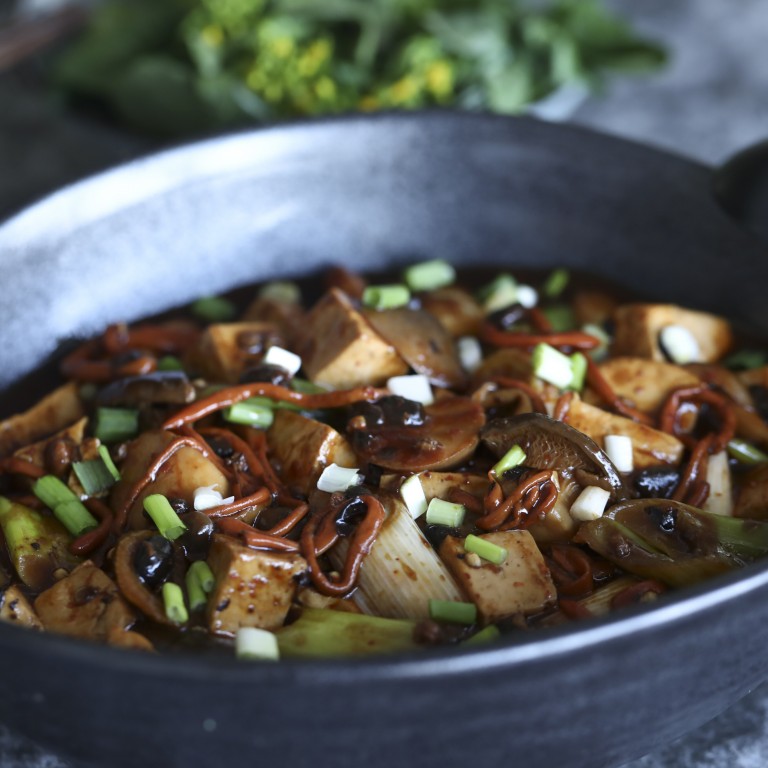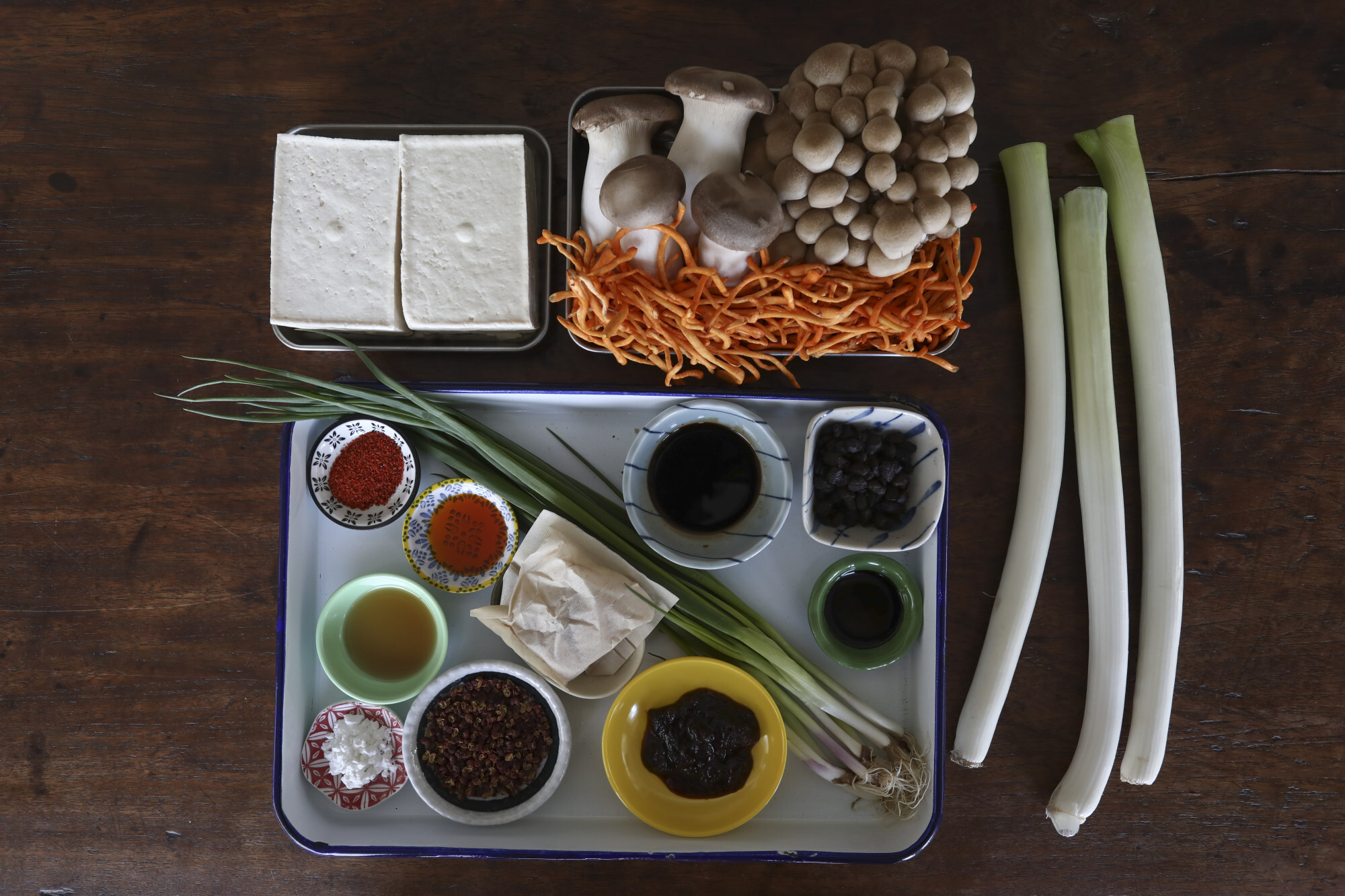
How to make vegetarian mapo tofu – who needs meat when you have mushrooms? They add all the rich texture you need
- Mapo tofu doesn’t have much meat to start with, and it’s easily replaced by mushrooms
- It’s best to use at least two types of mushroom, and home-made vegetarian stock is preferable; if you haven’t any, make do with a vegetarian dashi bag
Like a lot of people, I am making the effort to eat less meat, especially when dining at home. I’ve never cooked with mock meat, but where I can, I substitute the original protein-rich vegetarian staple of bean curd and mushrooms.
Vegetarian mapo tofu
Mapo tofu was easy to convert into a vegetarian/vegan version, because the original dish had only a scant amount of meat in the first place. I actually prefer mapo tofu without meat, because mushrooms add so much texture.
Use at least two types of mushroom – most of which should have thick stems (I like king oyster mushrooms). Thinner mushrooms – such as cordycep flowers or enoki – should be added towards the end of the cooking process.
How to make Hong Kong-style waffles: two recipes for a local favourite
This recipe is adapted from one by Sze King-chun, who was chef at an excellent Sichuan restaurant, Bistro Jinli (now closed), in Ap Lei Chau, Hong Kong. The original recipe was published in my first cookbook, A Celebration of Food (2012). If you have home-made vegetarian stock in your fridge or freezer, use that instead of the stock made with a vegetarian dashi bag.
Doubanjiang is Sichuan chilli bean sauce or paste. For the chilli powder, if possible, use the type made of Tianjin chillies. You will need to adjust the amount of chilli powder, peppercorn chilli oil and chilli oil to suit your tastes.

Ingredients
-
15 grams (½ oz) fermented black beans
-
1 vegetarian dashi bag
-
1-2 Japanese or Chinese leeks, about 150 grams (5⅓ oz)
-
325 grams (11 ½ oz) fresh mushrooms, at least two types
-
5 grams (3 ½ tsp) Sichuan peppercorns
-
60 grams (2 oz) Sichuan chilli bean sauce or paste (doubanjiang)
-
5 grams (1 tbsp and ½ tsp) chilli powder, preferably Tianjin chilli powder
-
15ml (1 tbsp) light soy sauce
-
15ml (1 tbsp) dark soy sauce
-
15ml (1 tbsp) sesame oil
-
10ml (2 tsp) peppercorn chilli oil
-
10 grams (scant 2 tbsp) cornstarch
-
15ml (1 tbsp) Chinese chilli oil, or to taste
-
450 grams (1 lb) medium-firm bean curd
-
10ml (2 tsp) cooking oil
-
1-2 spring onions

1. Briefly rinse the black beans under running water, then drain them and put them in a bowl. Add 45ml (3 tbsp) of hot water, then set aside to soak.
2. Put the dashi bag in a measuring cup and add 400ml (1⅔ cups) of boiling water. Let it soak for about two minutes, then remove the dashi bag and squeeze it over the cup, to extract the flavour. Discard the bag.
3. Trim off the end of the leek(s), then slice on the diagonal into 1.25cm (½ inch) pieces.
4. For thick mushrooms (such as king oysters), trim off the caps, then cut them in quarters. Slice the stems in half lengthwise, then slice them into 1.25cm (½ inch) pieces. If using button mushrooms, cut them in halves or quarters, depending on size. If using straw mushrooms, slice them in half.
Eating two mushrooms a day nearly halves cancer risk, study finds
For white or brown shimeji mushrooms, trim off and discard the woody ends, then cut the mushrooms in half so they are shorter. If using enoki mushrooms, trim off and discard the woody ends, then break the mushrooms into clumps. Cordycep flowers can be used as they are.
5. Remove and discard the seeds (if any) from the Sichuan peppercorns, leaving behind only the husks. Put the husks in a small, unoiled skillet (or a sesame seed toaster) and toast them over a medium flame, shaking the pan constantly. Cool the peppercorns, then use a mortar and pestle to grind them to a rough powder.
6. Put the light and dark soy sauces in a bowl and add the sesame oil and peppercorn chilli oil.
7. Put the cornstarch in a small bowl and add 30ml (2 tbsp) of cool water.

8. Drain the bean curd, then cut it into 1.25cm (½ inch) cubes. Bring a pot of water to the boil, add the bean curd and cook for one minute. Use a slotted sieve to carefully lift the bean curd pieces out of the water. Drain them briefly, then place them on a paper towel-lined tray or plate.
9. Heat a wok over a medium-high flame, and when it’s hot, pour in the oil. Add the doubanjiang and let it come to a simmer, then add the black beans (and soaking liquid), Sichuan peppercorns and chilli powder. Stir until just incorporated.
10. Immediately pour in the dashi stock and let it come to a simmer, then add the leek and the large and medium mushrooms. Simmer for about two minutes, then stir in the soy sauce mixture.
11. Add the bean curd and simmer for about a minute.

12. Stir the cornstarch and water, then pour about three-quarters of the mixture into the wok, stirring carefully so as not to break up the bean curd pieces too much. Simmer for about 30 seconds, or until slightly thickened; if you like a thicker sauce stir in the remaining cornstarch/water. Stir in the chilli oil, then taste for seasonings and correct, if necessary.
13. Ladle the ingredients into a serving bowl. Mince the spring onion and scatter the pieces on top. Serve immediately.
Food styling: Nellie Ming Lee. Kitchen courtesy of Junk Kitchen











